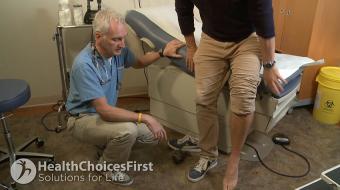Featured Videos
Gout is an autoimmune disease caused by a buildup of uric acid in the body and uric acid crystals in the joints. It's the most common type of inflammatory arthritis, causing painful flares of red, swollen, hot-feeling and sore joints. The big toe is the most common joint affected by gout, but other joints can be affected.
Who Gets Gout?
Most commonly, gout affects men in their 40s and 50s. It commonly runs in families, so it is likely that genetics play a role in the development of this disease. Gout almost never affects women until they reach menopause or have a kidney problem.
Gout is more common in people who have kidney problems or who are taking certain medications.
Symptoms of Gout
Sudden and Severe Pain in a Joint
Gout commonly presents suddenly as an attack often happens in the early hours of the morning. In many cases, a person with gout goes to bed feeling fine, and wakes up with a burning joint.
In most patients, one joint is affected by gout at first (commonly the big toe).
Multiple Joint Pain
As gout worsens, more than one joint may be affected, such as the ankle, knee or foot. If it becomes severe, it can also affect the elbows, wrists and fingers.
Deposits of Hardened Uric Acid
In some patients with gout, uric acid levels remain very high for a long time, This can lead to crystallization in other tissues and deposits of hardened uric acid, called tophi.
In many cases, tophi is painful and develops over the elbows, in the finger pads, on the backs of the hands or on the tendons behind your ankles or on the outer edges of the ears. If left untreated, tophi can actually rupture or damage to nearby bone and tendons.
Chronic Gout Episodes
Because gout can be a chronic condition, people may experience continous swollen joints or mini-attacks. If uric acid levels stay high, the crystals continue to form, which can lead to long-term damage to the joints. It can even destroy them.
Frequency & Duration of Flares
Typically, gout flares go away after 7 to 10 days of treatment, and then it can be several months or years before another flare occurs. Chances are, if a person has had one attack of gout, they will eventually have others.
Common Tests for Gout
Joint fluid tests: In order to look for crystals of uric acid, a physician will use a needle to draw a sample of the fluid in an affected joint. The fluid is then inspected under a microscope to look for uric acid crystals.
Laboratory culture: To rule out and infection, your rheumatologist may take some fluid from an affected joint. This fluid can be cultured on a laboratory dish to see whether or not bacteria grow.
- Blood tests: This test can detect high levels of uric acid in their blood.
- Creatinine test: A blood test can help doctors assess kidney function and see how well kidneys can clear uric acid from the body.
Scans
In addition to blood tests, your physician may recommend scans to diagnose gout, including:
- Ultrasound to show crystals of uric acid or tophi in a joint
- X-rays to rule out other types of arthritis
Managing Gout
The best way for patients to manage gout is by keeping levels of uric acid in a healthy range. To limit uric acid production, it's important to avoid or limit foods such as meats, fish and seafood, alcohol and sugary drinks.
Gout Treatment
Gout treatment involves initially reducing the pain and swelling plus keeping uric acid at normal levels to reduce or prevent further attacks. Your rheumatologist will want to completely treat your gout attack before you lower uric acid levels, which should ideally be below 360 umol/L (6 mg/dL). Non-steroidal anti-inflammatory drugs (NSAIDs), prednisone, colchicine, allopurinol, febuxostat and steroid injections can be effective gout treatments.
Some patients will be put on a prevention therapy - a medication they take daily and a local rheumatalogist can often help withg this.. If their level of uric acid is still not low enough, they may have to undergo treatment with acute drugs for a period of time. In terms of lifestyle changes, one of the best ways to prevent gout attacks is to maintain a healthy body weight.
Find more resources on gout.
Print this Action Plan and check off items that you want to discuss with your healthcare provider
-
If you have gout, the most commonly affected joint is the big toe, but other joints in the foot, ankle, knees, wrists and elbows can be involved.
-
Gout is often diagnosed after an attack, which happens suddenly and usually in the early morning hours.
-
In general, gout flare-ups last between 7 and 10 days. If you experience enough gout attacks, your joints can be permanently damaged.
-
Gout treatment involves initially reducing the pain and swelling plus keeping uric acid at normal levels to reduce or prevent further attacks.
-
Non-steroidal anti-inflammatory drugs (NSAIDs), prednisone, colchicine, allopurinol, febuxostat and steroid injections can be effective gout treatments.
Adherence:
Adhering to your medications, prescribed exercises or lifestyle changes (such as dietary changes, smoking cessation, reduced alcohol consumption, etc.) is essential to improving health outcomes successfully. Compliance to any prescribed treatment is the number one thing you can do to ensure positive changes and optimal treatment outcomes.
Resources for Patients
- Rheumatoid Arthritis
- Ankylosing Spondylitis
- Methotrexate and Dosing
Useful links
Gout is a form of inflammatory arthritis characterized by recurrent attacks of a red, tender, hot, and swollen joint.[3] Pain typically comes on rapidly in less than twelve hours.Seeing a Family Physician or rheumatologist can help with treatment and diagnosis A local Registered Dietcian can help with weight loss and food and beverage choices.

